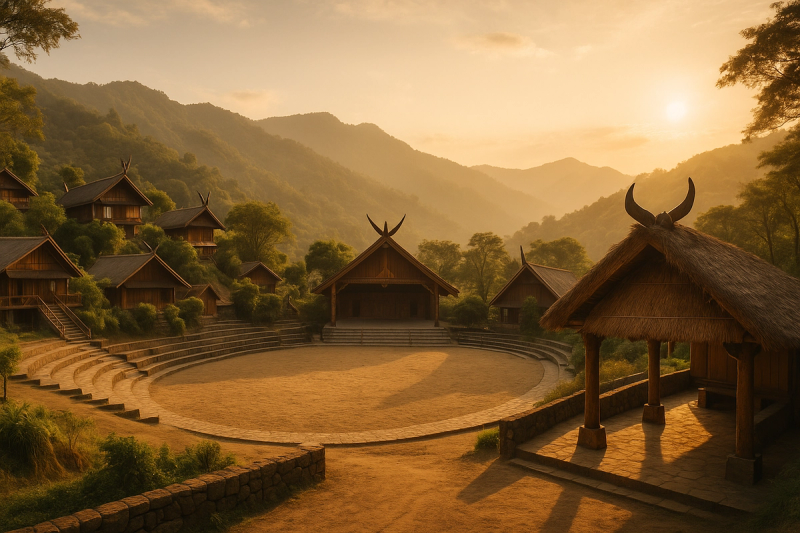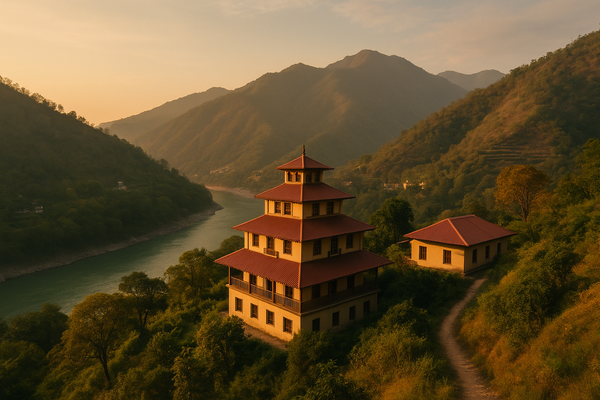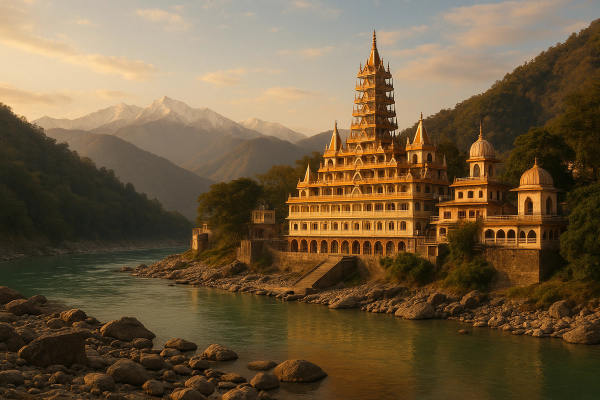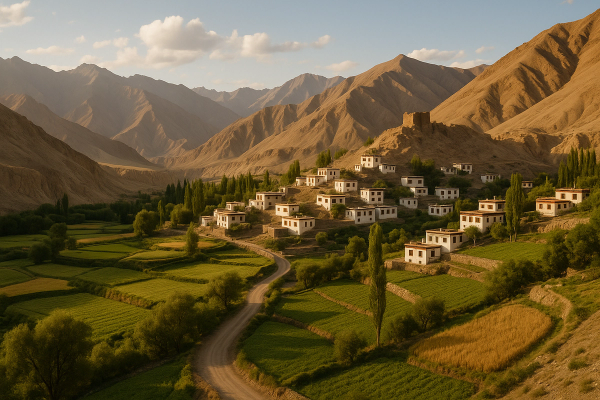Hornbill Festival Kohima, Nagaland: Travel Guide – messy, magical, and totally worth it#
Okay, quick heads up before we dive in. I haven’t physically stood at Kisama with a drum in my hand yelling woohoo, but this guide pulls in real stuff from locals, recent attendees, and official updates. I’ve been obsessing over Hornbill for years, talking to Naga friends, stalking travel forums, and yeah, doing the boring research bit so you don’t have to. So it reads like a chatty, slightly chaotic Indian traveler’s diary-meets-guide. If you’re planning to go, trust me, this’ll help.¶
What exactly is Hornbill Festival?#
Hornbill is Nagaland’s biggest cultural festival, held every year from December 1 to 10 at Kisama Heritage Village, about 12 km outside Kohima. It’s sometimes called the “Festival of Festivals” because all the major Naga tribes come together – think vibrant shawls, log drums, slow-smoked pork, warrior dances, bamboo crafts, and that famous Raja mircha (king chili) that’ll make you question your life choices. You’ll see morungs (traditional community houses) for different tribes, live performances daily, indigenous games, craft bazaars, and a night carnival in Kohima. It’s intense but in the best way.¶
Why it hits different (for us desi travelers)#
Honestly, it’s one of those places where culture isn’t packaged and prettified – it feels lived. People are chill, English is widely spoken, Nagamese too, and there’s this warm community vibe. Plus, food stalls that’ll kind of blow your mind, a mix of traditional and new-age stuff, local coffee (Nagaland coffee is trending hard right now), and music everywhere. You can hop from event to event, sit by the morungs, chat with artisans, and end the night with street food under fairy lights in Kohima town. It feels familiar but also totally new.¶
Latest travel updates you should actually know#
- Dates: December 1–10 every year. No surprises. Plan early.
- Location: Kisama Heritage Village, Near Kohima. Night carnival happens in Kohima town (usually around Razhu Point stretch) with food and music.
- Permits: Inner Line Permit (ILP) is required for Indian citizens entering Nagaland (Dimapur town is typically exempt). You can apply online now – e-ILP is a thing, and very useful. Carry a printed or soft copy. Foreigners usually don’t need PAP, but they must register at the nearest Foreigner Registration Office. Double-check official portals before you travel.
- Safety: Heavy police presence at the festival. Drones typically not allowed without prior permissions. Bag checks happen. It’s safe for solo travelers.
- Connectivity: Jio and Airtel work but can be patchy at Kisama. UPI works at many stalls, but carry cash. ATMs in Kohima.
- Entry fee: There’s usually a small daily entry fee at Kisama. Think a ballpark of Rs 50–100 per person per day. Could vary.
- Getting around: Shared taxis and local cabs run between Kohima and Kisama all day during the festival. Prices fluctuate; budget Rs 100–200 per person one-way for shared rides, more for private cabs.
- Weather: Cool and crisp. Days mild, nights can hit 6–8°C. Layer up. Bring a light rain jacket – mist and surprise drizzles happen.¶
Getting there without losing your mind#
The easiest way is to fly into Dimapur (DMU). There are flights from Kolkata, Guwahati, Delhi (often via Guwahati), and sometimes more seasonal routes. From Dimapur, Kohima is around 2–3.5 hours by road depending on traffic and road work. Shared taxis (Sumo/Winger) are popular – around Rs 300–500 per seat. NST buses also run but get booked out fast around festival season.
Pro tip: land in Dimapur before noon, grab lunch, and head up to Kohima with daylight. Driving at night in the hills is… no. Just no.¶
Where to stay (and not get price-shocked)#
December is peak season, obviously. Book early – like months early if you can.
- Homestays in Kigwema, Jakhama, Viswema: great for proximity to Kisama. Budget around Rs 800–1500 per person for dorm/beds; Rs 2000–4000 per room for comfy homestays.
- Mid-range hotels in Kohima: Rs 3000–6000. Hot water, heating, decent breakfast. Book on reputable platforms or via direct WhatsApp.
- Premium stays: Rs 7000–12,000+ if you want boutique vibes or scenic views.
- Camping at Dzüko Valley (if you detour): budget Rs 600–1200 for dorm/bed. Nights get freezing, so don’t be brave without thermals.
If you want to catch the night carnival and still reach Kisama daily, stay in Kohima. If you want mornings in Kisama, stay in Kigwema/Jakhama. Simple.¶
What a day at Hornbill actually looks like#
You start slow – wander the morungs, breathe in the smoky smell of meat and bamboo, grab tea, and stake out a spot near the main arena. Cultural performances happen in slots throughout the day: warrior dances, log drum beats, indigenous games, tug-of-war style contests, fire-making demonstrations, hornbill myth storytelling, and yeah, sometimes chili-eating competitions because why not. There’s a craft bazaar – textiles, beadwork, bamboo products, baskets, jewelry – all ridiculously photogenic and pretty affordable. Eat snacky things from stalls, then head to Kohima in the evening for the carnival: music, food stalls, street crowds, and that happy chaos.¶
Food you absolutely shouldn’t skip#
- Smoked pork with bamboo shoot
- Pork with axone (fermented soybean)
- Galho (Naga rice porridge)
- Beef or fish with king chili chutney (Raja mircha)
- Sticky rice, snails if you’re adventurous, seasonal greens
- Zutho (local rice beer) – served in cultural contexts. Respect local rules and customs
- Local coffee – trust me, Nagaland coffee is getting big, smooth and aromatic
Go easy on the chili until your soul says go. And go early for lunch – popular stalls finish stuff fast.¶
Ask before you photograph people. You’ll get a smile and a nod more often than not. Consent matters, even for selfies.
Events beyond the main stage – btw, don’t miss these#
- Indigenous games: greased bamboo pole climbing, archery, log drum rolling, fire-making.
- Handloom and craft demos: weaving, beadwork techniques, basket making.
- Music: There’s often a Hornbill Music Festival component that may happen in Dimapur or Kohima depending on the year. Bands, indie acts, sometimes rock contests. Details get announced closer to the dates.
- Literature/film/art side-events: keep an eye out for pop-up talks, screenings, exhibitions.
- Night carnival in Kohima: food, artisanal stalls, performances, and honestly, perfect people-watching.
Schedule changes happen. Check the official Hornbill Festival socials and Nagaland Tourism updates for the line-up once it’s out.¶
Budgeting – how much to carry, what to expect#
- Entry tickets: Rs 50–100 per day per person, approx.
- Local taxis: Kohima to Kisama and back, Rs 200–600 depending on shared/private rides.
- Food: Rs 150–400 per meal at stalls, more at restaurants.
- Shopping: crafts can be Rs 100–2000+, textiles go higher. Bargain lightly and nicely.
- Stay: Rs 800–12,000 per night depending on type.
UPI is widely used, but internet can glitchy. Carry some cash (Rs 3000–6000 for two days feels safe). ATMs are in Kohima but get crowded during the fest, so withdraw a little earlier in the day.¶
Packing list that saved folks from crying#
- Layers: thermals, fleece, a windproof jacket
- Good shoes: you’ll walk a lot, sometimes mud
- Power bank, torch (night carnival can be dark in bits)
- Reusable water bottle (refill points are there, and plastic waste is a big no-no)
- Cash + UPI
- Simple meds: cold and headache tablets, band-aids
- Rain cover or light poncho
- Sunscreen + cap – yes, winter sun can still burn
- Earplugs if you’re sensitive to sound (drums are loud and glorious)
Oh and a scarf. Dusty afternoons happen. Protect your face a little.¶
Culture etiquette: what not to do (and what to do, please)#
- Ask for permission before photos and videos, especially inside morungs.
- Drones? Usually a no unless you’re media or have permits.
- Respect elders. A polite nod goes a long way.
- Don’t touch ceremonial items unless invited.
- Dress modestly and warmly – you’re in a community space, not a rave.
- No littering. Separate trash. You’ll see signs and bins.
- Alcohol rules exist. Cultural drinks are served in context – don’t be that person.
- Learn a few words of thanks. English is common, but even a simple smile and “thank you” in a gentle tone is gold.¶
Best months to visit Nagaland, if Hornbill dates don’t work for you#
December is peak because of Hornbill. But honestly October–February is great for clear skies and cool temps. Monsoon months are lush but roads can be messy. If crowds freak you out, go right after the fest – markets still buzzing, weather still nice, and you’ll get breathing space. Spring gets pretty too, with flowers popping around Kohima and villages.¶
Side trips you’ll brag about later#
- Dzüko Valley: Day hike from Viswema or Jakhama. Rolling green, winter golden. Trails are well-marked. Start early, carry water, pack out all trash.
- Japfu Peak: For sunrise chasers. Moderate hike, killer views.
- Khonoma Green Village: A conservation success story – once known for hunting, now proud of preserving. Guided village walks, terraces, old homes, storytelling.
- Kohima War Cemetery: Quiet, poignant. War history, manicured gardens.
- Cathedral of Kohima: Beautiful architecture, calm spaces.
All these are easily doable from Kohima with a cab or local taxi.¶
Staying connected – literally and socially#
Network can be spotty at Kisama. Download maps offline. Save your homestay’s number and address. People are super helpful – ask for directions, share a cab if you’re solo. Social vibe is excellent; travelers form groups fast. If you get overwhelmed, find a tea stall, take a breather. It’s a lot, in a good way.¶
Is Hornbill safe? What about women travelers, families, seniors?#
Short answer: yes. It’s one of the safest big festivals I’ve heard of recently. Police, volunteers, organizers – all very present. Families come in large numbers. Women travelers are common, and honestly the community energy is caring. Seniors should aim for seating in the main arena and avoid long standing spells. For kids, carry snacks, water, and warm layers.¶
Little money-saving hacks that aren’t stingy#
- Book homestays directly through trusted hosts – WhatsApp works.
- Use shared taxis between Kohima and Kisama.
- Eat at festival stalls – local food is filling and budget-friendly.
- Buy crafts at morung bazaars – prices often fair, plus you support artisans directly.
- Travel in a small group for cab cost splits.
Also, arrive with an open plan. Over-scheduling is the enemy of spontaneous fun.¶
Common mistakes we keep repeating (so don’t)#
- Reaching Kohima late at night. Just don’t.
- Forgetting ILP or leaving it in some folder that’s like nowhere.
- Wearing new shoes without breaking them in. Blisters galore.
- Not drinking enough water. High altitude-ish dryness hits hard.
- Overshooting chili on day one. Pace yourself.
- Shooting close-up photos of performances without permission.
Basically, be prepared and chill. It’s a festival, not a race.¶
A sample 3-day Hornbill plan that doesn’t rush you#
Day 1: Dimapur to Kohima. Check-in. Evening night carnival. Street food, craft browsing, live music.
Day 2: Kisama full day. Entry by 10 am, performances, lunch at stalls, morung hopping, handloom demo. Return to Kohima for dinner.
Day 3: Morning Dzüko or Khonoma. Back to Kisama for closing performances or a final craft run. Buy souvenirs and coffee. Chill.
Stretch to 4–5 days if you can, and add Japfu sunrise or more lazy carnival evenings.¶
Pricing trends and availability this season#
Expect prices to be higher on opening weekend and towards the grand finale. Homestays fill first near Kisama, then Kohima hotels. Coffee stalls and artisanal brands have grown big recently – great gift options. Many vendors accept UPI now, but do carry cash since network hiccups are common. As of 2025-ish, ILP is online and quicker to process. Keep screenshots. Keep backups. Keep calm.¶
Responsible travel – yep, it matters#
Nagaland’s hills are fragile. Use refillable bottles. Don’t step on flower beds for that one Instagram shot. Keep your noise levels decent around morungs. Buy local crafts, not mass-produced tat. Leave places better than you found them – it sounds cheesy but it’s the only way we keep coming back without ruining it.¶
Final thoughts before you book that ticket#
If you’re craving something that’s loud and gentle at the same time, Hornbill’s your thing. The warmth, the food, the music, the craftsmanship – it’s like being welcomed into someone’s living room… but with thousands of people and giant drums. Go with respect, curiosity, and a good jacket. Don’t overplan. Let a few hours just happen. You’ll come back with stories, and probably a few bamboo baskets too. And if you want more real-world guides and chatty travel notes, check out AllBlogs.in – I keep finding useful stuff there when I’m piecing trips together.¶














